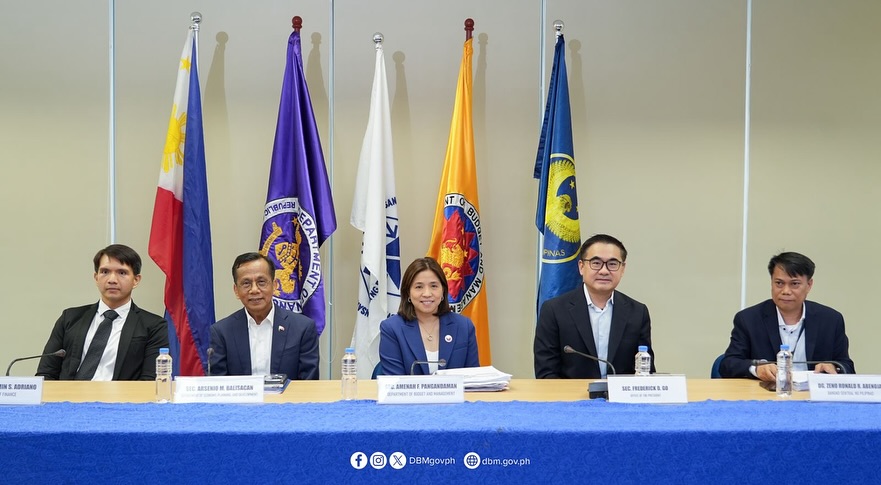
By Anna Leah Gonzales | Philippine News Agency
Economic managers on Thursday revised the economic growth target for this year amid mounting global uncertainties.
At a briefing after the 191st Development Budget Coordination Committee (DBCC) meeting, Budget Secretary and DBCC Chair Amenah Pangandaman said the economic growth assumption for 2025 was revised downward to 5.5%–6.5% from the previous 6%–8%.
For 2026 to 2028, the Philippine economy is projected to expand by 6%–7%, reflecting a more cautious and resilient economic outlook amid global headwinds.
“The revisions take into account heightened global uncertainties, such as the unforeseen escalation of tensions in the Middle East and the imposition of U.S. tariffs,” Pangandaman said.
She said that despite these challenges, the DBCC remains “vigilant and ready to deploy timely and targeted measures” to mitigate their potential impact on the Philippine economy.
The budget chief said the country continues to be one of the fastest-growing economies in ASEAN driven by robust domestic demand.
To maintain this momentum, she highlighted the administration’s focus on structural reforms, including the Corporate Recovery and Tax Incentives for Enterprises to Maximize Opportunities for Reinvigorating the Economy (CREATE MORE) Act and the Public-Private Partnership (PPP) Code, both designed to enhance the country’s trade and investment competitiveness.
Pangandaman said the government will also pursue the approval and implementation of other reforms recently ratified by Congress, such as the Liberalizing the Lease of Private Lands by Foreign Investors Act, Enhanced Fiscal Regime for Large-Scale Metallic Mining Act, Accelerated and Reformed Right-of-Way (ARROW) Act, and Konektadong Pinoy Act.
The DBCC also revisited the medium-term macroeconomic assumptions to take into consideration recent global and domestic developments.
The inflation assumption for this year was cut to 2%–3% from the previous 2%–4%.
For 2026 to 2028, the inflation assumption was retained at 2%–4%.
For 2025 to 2028, crude oil price assumptions were reduced to $60 to $70 per barrel from $60 to $80 per barrel, despite escalating geopolitical tensions.
The foreign exchange rate is assumed to remain stable, averaging at P56 to P58 per U.S. dollar from 2025 through 2028, supported by lower domestic inflation.
Pangandaman said it will continue to be shaped by global financial conditions and external trade performance.
Trade forecasts were also refined to align with global market developments.
Goods exports are projected to contract by 2% in 2025, largely due to slower global demand and heightened trade policy uncertainties, before growing by 2% from 2026 to 2028.
Goods imports are expected to grow by 3.5% in 2025 due to resilient domestic economic activity and further increase to 4% in the succeeding years, supported by stable domestic consumption and sustained infrastructure spending.
Medium-term fiscal program
The revenue outlook for this year was revised downward to P4.52 trillion from the previous P4.64 trillion.
Revenue collections are expected to increase steadily throughout the period, reaching 16.3% of gross domestic product (GDP) by 2028.
“Key drivers include the implementation of recently enacted revenue reforms, such as the VAT on non-resident digital service providers and capital markets efficiency promotion, as well as sustained improvements in tax administration, compliance enforcement, and digitalization initiatives,” Pangandaman said.
National government disbursements will remain a major growth driver over the medium term, averaging 21.1% of GDP annually.
Infrastructure spending, meanwhile, will be sustained at 5%–6% of GDP each year.
Pangandaman said this will ensure continued improvements in physical connectivity.
“Public investments will also focus on education, healthcare, agriculture, digital transformation, and social protection, as reflected in the priorities under the Philippine Development Plan (PDP) 2023–2028,” she said.
The DBCC assured that the government remains resolute in advancing a growth-enhancing fiscal consolidation agenda that promotes a resilient, inclusive, and sustainable economy.
“By nurturing future-ready generations through coordinated policy implementation and strategic investments, the government is committed to reducing poverty to single-digit levels, creating quality jobs, safeguarding macroeconomic stability, and ultimately achieving our Agenda for Prosperity in the Bagong Pilipinas—even amidst global uncertainties,” Pangandaman said.
